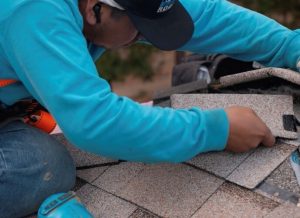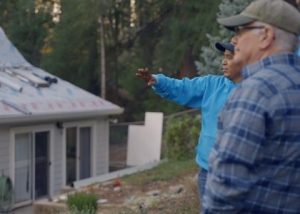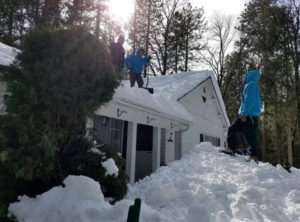As winter looms on the horizon, safeguarding your roof against the impending onslaught of harsh weather becomes paramount. From inspecting for potential damage to cleaning gutters and debris, we’ve compiled a comprehensive checklist to ensure your roof remains secure and leak-free throughout the snowy season.We’ll also shed light on the vital role of proper insulation and ventilation in averting ice dams and potential roof collapses. By heeding these practical tips and taking proactive measures, you can fortify your home against potential winter roofing woes and relish a worry-free season.

Among the primary reasons to winterize your roof is the prevention of leaks and water damage. Accumulated snow and ice can lead to melting and refreezing, forming ice dams that obstruct proper drainage. This can result in water seepage, causing significant damage to your walls, ceilings, and personal belongings.
Another critical incentive for winterization is the extension of your roof’s lifespan. The combination of extreme cold and heavy snow loads can strain your roof, potentially causing structural damage and premature aging. Proactive measures to ensure your roof’s stability can lead to a longer life, sparing you from costly repairs or replacements.
Commence the winterization process with a thorough inspection for damaged or missing shingles. These weak spots can allow water infiltration and lead to leaks. Look for signs like curling, cracking, or blistering shingles, and promptly replace them.
 Examining Flashing and Seals
Examining Flashing and SealsBeyond shingles, scrutinize the flashing and seals around chimneys, vents, and skylights. Damaged flashing or deteriorated seals in these areas can lead to leaks. Ensure secure flashing and intact seals to prevent water penetration.
Clogged gutters pose a risk of water backup, potentially damaging your roof and foundation. Before winter sets in, clear debris and leaves from your gutters. This will ensure unimpeded water drainage and avert the formation of ice dams.
 Fixing Small Damages
Fixing Small DamagesSwiftly address any minor damages observed during your inspection, such as small cracks or gaps. Utilize roofing cement or sealant to mend these areas, preventing further water intrusion.
For severely damaged shingles that cannot be repaired, timely replacement is crucial. This ensures the integrity of your roof and its ability to shield your home from the elements.
Inspect the roof deck for any gaps or cracks and seal them effectively. These openings can permit water and cold air to enter your home, compromising insulation and potentially leading to energy loss.
Proper insulation is instrumental in preventing heat loss and maintaining a comfortable indoor temperature during winter. It not only trims energy costs but also safeguards your roof from potential ice dam formation.
Selecting the appropriate insulation material is pivotal to suit your specific requirements. Consider factors like R-value, moisture resistance, and fire safety for optimal performance.
The attic is a focal point for heat loss. Adequate insulation not only keeps living spaces warm but also thwarts ice dam formation on your roof. Install insulation between the attic joists, ensuring no gaps or voids.
 Trimming Branches Near the Roof
Trimming Branches Near the RoofOverhanging tree branches can pose a threat during winter storms. Trim branches in close proximity to your roof to minimize this risk, preventing potential damage from breakage due to snow or ice.
Dead or diseased branches hanging over your roof should be removed before winter arrives. These branches are more prone to breakage under the weight of snow or ice, potentially causing significant roof damage.
Safety should be paramount when clearing snow from your roof. Utilize a roof rake from ground level to avoid climbing onto the roof. This minimizes the risk of accidents and potential roof damage.
 Preventing Ice Dams
Preventing Ice DamsIce dams form when melting snow refreezes at the roof’s edge, impeding proper drainage. Consider installing roof heating cables or using calcium chloride ice melt products to avert ice dam formation.
Despite preventive measures, ice dams may still occur. Be vigilant for warning signs such as icicles or water stains. Take immediate action if you notice these signs to prevent further damage.
Effective ventilation is imperative for a healthy and robust roof. It expels excess heat and moisture, thwarting mold, mildew, and ice dam formation.
Regularly inspect your roof vents to ensure they are free from debris like leaves or bird nests. Blocked vents impede airflow, potentially leading to inadequate ventilation and roof issues. Clean vents as needed to maintain optimal airflow.
Winterizing your roof is a pivotal step in safeguarding your home and ensuring its longevity. By adhering to the steps outlined in this guide, you can mitigate the risk of leaks, water damage, and other roofing issues during the snowy season. Remember, prevention is key when it comes to maintaining a secure and leak-free roof. Stay proactive and enjoy a worry-free winter.
Remember, your roof is your home’s first line of defense against the elements, so investing in its care and maintenance will save you time, money, and headaches in the long run.
As a locally owned and operated business, we care deeply about the people around us. We strive to be a valuable resource to our community.
Please reach out even if you just have a question or need some direction!